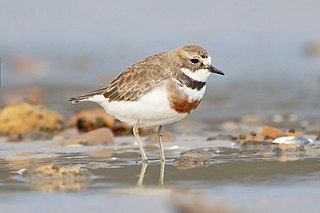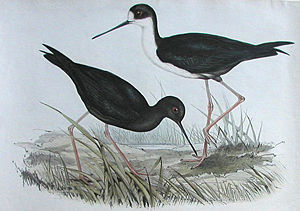
Stilt is a common name for several species of birds in the family Recurvirostridae, which also includes those known as avocets. They are found in brackish or saline wetlands in warm or hot climates.

The Recurvirostridae are a family of birds in the wader suborder Charadrii. It contains two distinct groups of birds, the avocets and the stilts.

The American avocet is a large wader in the avocet and stilt family, Recurvirostridae, found in North America. It spends much of its time foraging in shallow water or on mud flats, often sweeping its bill from side to side in water as it seeks crustacean and insect prey.

The black-winged stilt is a widely distributed, very long-legged wader in the avocet and stilt family Recurvirostridae. Its scientific name, Himantopus himantopus, is sometimes used to generalize a single, almost cosmopolitan species. Alternatively, it is restricted to the form that is widespread in Europe, Asia and Africa, which equals the nominate group of H. himantopussensu lato. Meanwhile, the black-necked and white-backed stilts both inhabit the Americas; the pied stilt ranges from Australasia and New Zealand. Today, most sources accept between one and four actual species.

The Mackenzie Basin, popularly and traditionally known as the Mackenzie Country, is an elliptical intermontane basin located in the Mackenzie and Waitaki Districts, near the centre of the South Island of New Zealand. It is the largest such basin in New Zealand. Historically famous mainly for sheep farming, the sparsely populated area is now also a popular tourism destination.

The banded stilt is a nomadic wader of the stilt and avocet family, Recurvirostridae, native to Australia. It belongs to the monotypic genus Cladorhynchus. It gets its name from the red-brown breast band found on breeding adults, though this is mottled or entirely absent in non-breeding adults and juveniles. Its remaining plumage is pied and the eyes are dark brown. Nestling banded stilts have white down, unlike any other species of wader.

The white-fronted tern, also known as tara, sea swallow, black-billed tern, kahawai bird, southern tern, or swallow tail, was first described by Johann Friedrich Gmelin in 1789. A medium-sized tern with an all-white body including underwing and forked tail, with grey hues on the over the upper side of the wing. In breeding adults a striking black cap covers the head from forehead to nape, leaving a small white strip above the black bill.

The double-banded plover, known as the banded dotterel or pohowera in New Zealand, is a species of bird in the plover family. Two subspecies are recognised: the nominate Charadrius bicinctus bicinctus, which breeds throughout New Zealand, including the Chatham Islands, and Charadrius bicinctus exilis, which breeds in New Zealand's subantarctic Auckland Islands.
Hybridisation in shorebirds has been proven on only a small number of occasions; however, many individual shorebirds have been recorded by birdwatchers worldwide that do not fit the characters of known species. Many of these have been suspected of being hybrids. In several cases, shorebird hybrids have been described as new species before their hybrid origin was discovered. Compared to other groups of birds, only a few species of shorebirds are known or suspected to hybridise, but nonetheless, these hybrids occur quite frequently in some cases.

The red-crowned parakeet, also known as red-fronted parakeet and by its Māori name of kākāriki, is a small parrot from New Zealand. It is characterised by its bright green plumage and the red pattern on its head. This versatile bird can feed on a variety food items and can be found in many habitat types. It used to be classified as near threatened as invasive predators had pushed it out of its historical range but it is now at least concern. This species used to occupy the entire island, but is now confined to only a few areas on the mainland and some offshore islands.

The wrybill or ngutuparore is a species of plover endemic to New Zealand. It is the only species of bird in the world with a beak that is bent sideways in one direction, always to the right. A 2015 study found it to be within the Charadrius clade, with other New Zealand plovers its closest relatives; the nearest being the New Zealand dotterel or New Zealand plover, and then the double-banded plover or banded dotterel.

The black-fronted tern, also known as sea martin, ploughboy, inland tern, riverbed tern or tarapiroe, is a small tern generally found in or near bodies of fresh water in New Zealand, where it forages for freshwater fish, arthropods and worms. It has a predominantly grey plumage. Restricted to breeding in the eastern regions of the South Island, it is declining and threatened by introduced mammals and birds. It is rated as endangered on the International Union for Conservation of Nature (IUCN)'s Red List of Threatened Species.

The shore plover, also known as the shore dotterel, is a small plover endemic to New Zealand. Once found all around the New Zealand coast, it is now restricted to a few offshore islands. It is one of the world's rarest shorebirds: the population is roughly 200.

The variable oystercatcher is a species of wader in the family Haematopodidae. It is endemic to New Zealand. The Māori name is tōrea-pango. They are also known as 'red bills'.

The pied stilt, also known as the white-headed stilt, is a shorebird in the family Recurvirostridae. It is widely distributed with a large total population size and apparently stable population trend, occurring in Malaysia, Japan, the Philippines, Brunei, Christmas Island, Indonesia, Palau, Papua New Guinea, Australia, and New Zealand. It is listed as Least Concern on the IUCN Red List. It is sometimes considered a subspecies of the black-winged stilt.

The Kermadec red-crowned parakeet, also known as the Kermadec red-fronted parakeet or Kermadec parakeet, is a parrot endemic to New Zealand's Kermadec Islands in the south-west Pacific Ocean. It is a subspecies of the red-fronted parakeet, and sometimes considered a full species. It is also the first documented example of a parrot recolonising an island after the removal of invasive predators.

The Canterbury-Otago tussock grasslands is an ecoregion of the South Island, New Zealand, part of the wider tussock grasslands of New Zealand.

The black-necked stilt is a locally abundant shorebird of American wetlands and coastlines. It is found from the coastal areas of California through much of the interior western United States and along the Gulf of Mexico as far east as Florida, then south through Central America and the Caribbean to Brazil, Peru and the Galápagos Islands, with an isolated population, the Hawaiian stilt, in Hawaii. The northernmost populations, particularly those from inland, are migratory, wintering from the extreme south of the United States to southern Mexico, rarely as far south as Costa Rica; on the Baja California peninsula it is only found regularly in winter. Some authorities, including the IUCN, treat it as a synonym of Himantopus himantopus.

The Hawaiian stilt is an endangered Hawaiian subspecies of the black-necked stilt species. It is a long-legged, slender shorebird with a long, thin beak. Other common names include the Hawaiian black-necked stilt, the aeʻo, the kukuluaeʻo, or it may be referred to as the Hawaiian subspecies of the black-necked stilt.
























